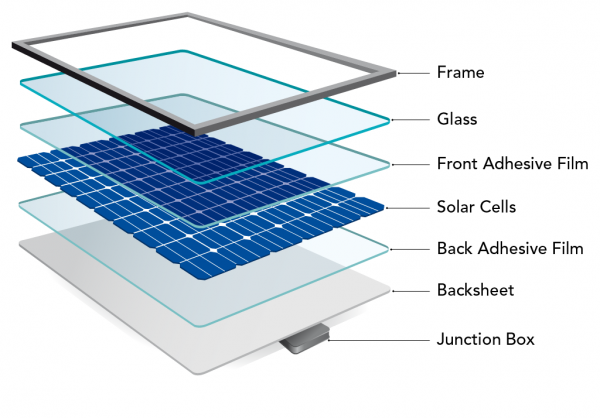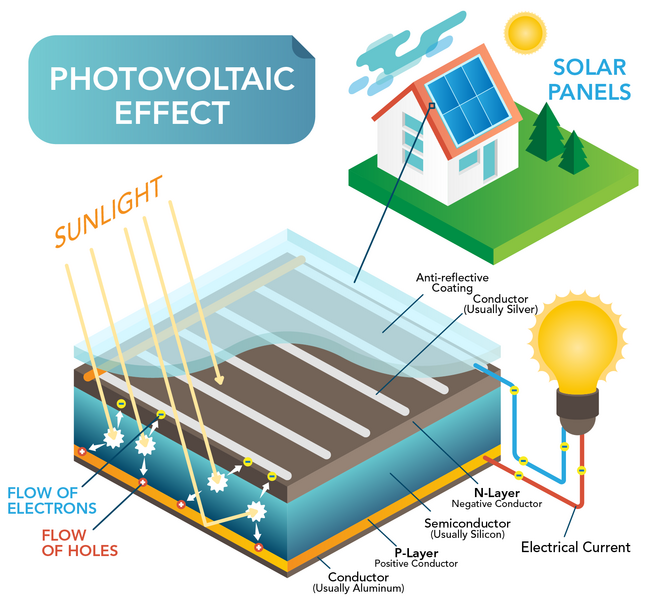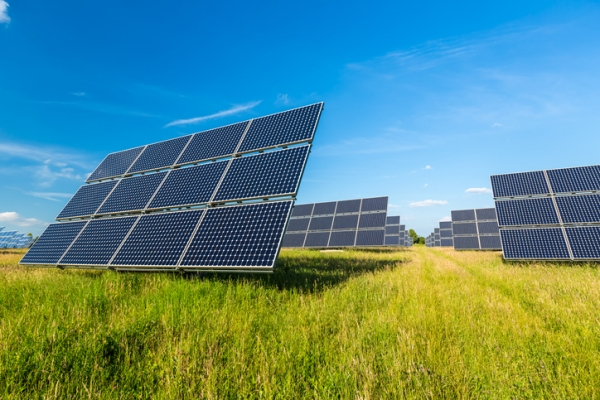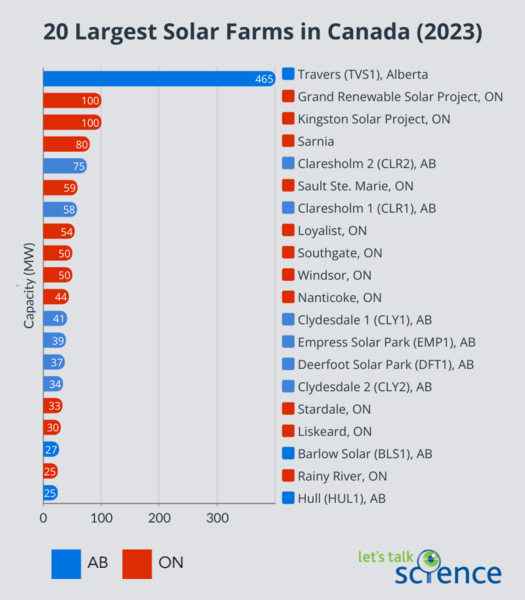Generating Electricity: Solar Cells
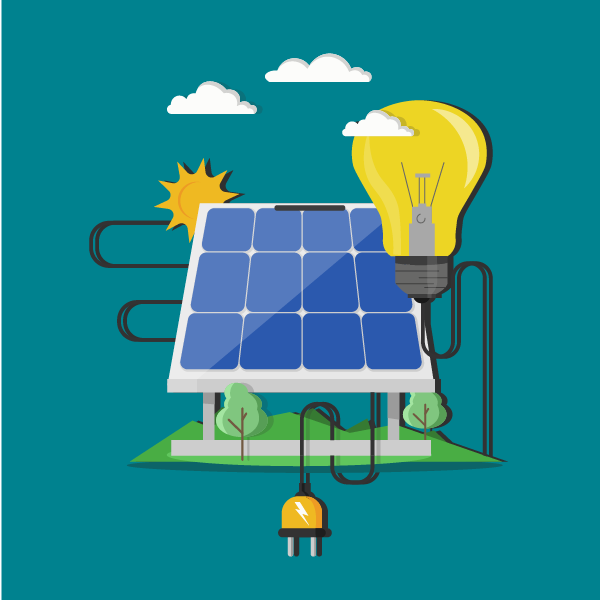
Solar power illustration (axel2001, iStockphoto)

Solar power illustration (axel2001, iStockphoto)
How does this align with my curriculum?
Learn how energy from the Sun can be used to generate electricity.
The Sun is a source of energy we use to generate electricity. This is called solar power. In Canada, we had the ability to generate 4000 megawatts of solar power in 2022. This is 25.8% more than we could generate in 2021! Although it makes up less than 1% of our total electricity generation, solar power is increasing in Canada.
Solar Power for Electricity
Solar power converts energy from the Sun into electrical energy. One way to do this is with photovoltaic materials. These can be used to create an electric current when they’re exposed to light. This is called the photovoltaic effect. Photovoltaic cells or solar cells can do this. Manufacturers often put lots of solar cells together to make solar panels.
A solar panel is made of solar cells sandwiched between layers of clear adhesive film. In front of this is a layer of glass held by a frame. Behind is a layer of aluminum called the backsheet which can conduct electricity. The electricity generated by the solar cells leaves the solar panel at the junction box.
Image - Text Version
Shown is a colour diagram of the seperate layers of material inside a solar panel. Starting at the top, the first layer is a dark grey outline of a rectangle. This is slightly larger and thicker than matching rectangular sheets below, so all of them can fit closely inside it. This is labelled “Frame.” Next is a transparent rectangle with a slight teal colour. This is labelled “Glass.” Below this is a layer of the same size and shape as the one above, but thinner and with a slight pale blue colour. This is labelled “Front adhesive film.” Next is the centre layer. This is a rectangular area made up of smaller dark blue rectangles striped with thin white lines. This is labelled “Solar cells.” Below is a layer labelled “Back adhesive film.” This looks the same as the front layer of adhesive film. The last rectangular layer is pale grey. This is labelled “Backsheet.” Below the backsheet, at the centre of one short edge of the rectangle, is a small, flat, dark grey box. This is labelled “Junction box.”
How do solar cells work?
Solar cells are usually made mainly from silicon. Silicon is a naturally-occurring chemical element. It is also a semiconductor. Semiconductors act as both a conductor and an insulator.
Did you know?
Silicon is the second-most abundant element on the planet, after oxygen.
A solar cell has three main layers.
- The top, or N-Type layer, can give away electrons easily. This layer faces towards the light. N-type stands for “negative type”. This layer is made of silicon and an element, such as phosphorus, which has more electrons than silicon.
- The middle layer is made of silicon. Photons of light with wavelengths in the range of 350 to 1 140 nm are absorbed in this layer. This is light in the visible part of the electromagnetic spectrum. The photons knock electrons off the silicon atoms. These loose electrons move to the N-type layer. The silicon atoms now have a positive charge. We call these “holes.” The holes move to the P-type layer.
- The bottom, or P-Type layer, can receive extra electrons. This layer faces away from the light.” P-type stands for “positive type”. This layer is made of silicon and an element such as boron, which has fewer electrons than silicon.
The loose electrons are collected by thin conductive strips of silver just above the N-type layer. The loose holes are collected by a thin, conductive sheet of aluminum just below the P-type layer. Connecting a wire between these two conductive materials allows the electrons to flow. A flow of electrons is an electric current.
Image - Text Version
Shown is a colour diagram of sunlight hitting a solar panel connected to a light bulb. The title “Photovoltaic Effect” is in block letters in the top left corner. Below is a blue, layered square with many labels. Above, yellow arrows point down from the word “Sunlight” in orange letters. Starting at the top, the first layer is thin, pale and translucent blue. It is labelled “Anti-reflective Coating.” Below, the second layer is thicker and brown with thin grey stripes along the top. The brown part is labelled “N-Layer: Negative Conductor.” The stripes are labelled “Conductor (Usually Silver).” The third layer is the thickest. It is deep blue and labelled “Semiconductor (Usually Silicon).” The fourth layer is much thinner and gold coloured. This is labelled “P-Layer: Positive Conductor.” The bottom layer is thinnest. It is dark grey and labelled “Conductor (Usually Aluminum).” Sunlight shines down through the anti-reflective coating and the N-Layer, into the semiconductor layer. Here, the points of the arrows are each surrounded with a white starburst shape. Two arrows point out from each of these. One points up to the thin silver strip on the N-Layer, where there is a small yellow circle marked with a minus sign. This is labelled “Flow of Electrons.” The other arrow points down to the P-Layer, where there is a small red circle marked with a plus sign. This is labelled “Flow of Holes.” To the right, a lightbulb glows yellow. A blue line leads from the left side of the base of the bulb to one of the silver conductor strips in the N-Layer. This is dotted with yellow circles representing electrons. A red line, also dotted with electrons, leads from the N-Layer to the right side of the bulb’s base. This is labelled “Electrical Current.” A thin black line leads from the layered square to an illustration of a house with solar panels on the roof. This is labelled “Solar Panels.”
How much power can a solar panel generate?
One standard solar cell is 15.6 cm x 15.6 cm square. It can generate about half a volt of electricity. That is about one third of the voltage of a fresh AA alkaline battery. That’s not very much.
Luckily you can connect solar cells together. Twelve photovoltaic cells is enough to charge a cellphone. Many solar panels are needed to power a house.
Image - Text Version
Shown is a colour photograph of long rows of large solar panels in a field. The camera is focused on the first solar panel. This is a large rectangle made up of smaller rectangular panels. These are joined together in a grid, four across and three down. Each small panel is dark blue with a grid of thin silver lines and a silver frame. The whole, larger panel is tilted so that these surfaces are facing up, toward a bright blue sky. Long, yellowish green grass grows below the panel. Behind the first panel, a row of identical panels stretches into the distance, disappearing on the horizon. To the right and left, are two more identical rows.
What is a solar farm?
You can often see many solar panels together. This is called a photovoltaic power station or a solar farm. In 2018, 98% of Canada’s solar energy was generated in Ontario. But many other regions have a lot of photovoltaic potential. These are some of the sunniest places in Canada!
Image - Text Version
Shown is a colour graph illustrating the capacities and locations of solar farms. The title is in bold letters across the top. The Y axis is labelled “Capacity (MW).” The X axis is marked from 0 to 400. 20 bars stretch to various points across the graph. Each is labelled with a number. Some are blue and some are red. A legend at the bottom of the page indicates that blue represents Alberta and red Ontario. The names and locations of each farm are listed on the right. Starting at the top, the first bar is blue and stretches across the whole width of the graph. It is labelled “465.” The list on the right reads “Travers (TVS1), Alberta. The next bar reaches a quarter of the way across. It is red and labelled 100. It reads “Grand Renewable Solar Project, ON.” The rest of the bars are labelled as follows: 100 MW, Kingston Solar Project, ON 80 MW, Sarnia ON 75 MW, Claresholm 2 (CLR2), AB 59 MW, Sault Ste. Marie, ON 58 MW, Claresholm 1 (CLR2), AB 54 MW, Loyalist, ON 50 MW, Southgate, ON 50 MW, Windsor, ON 44 MW, Nanticoke, ON 41 MW, Clydesdale (CLY1), AB 39 MW, Empress Solar Park (EMP1), AB 37 MW, Deerfoot Solar Park (DFT1), AB 34 MW, Clydesdale 2 (CLY2), AB 33 MW, Stardale, ON 30 MW, Liskeard, ON 27 MW, Barlow Solar (BLS1), AB 25 MW, Rainy River, ON 25 MW, Hull (HUL1), AB
Did you know?
The biggest solar farm in Canada is the Travers Solar Project in southern Alberta. It has a nameplate capacity of 465 MW. It first began generating electricity in 2022.
Solar power can be especially helpful in remote communities, which often rely on diesel generators for electricity generation. Getting the fuel to them is difficult and burning it to generate electricity releases greenhouse gases. In Fort Chipewyan, in a remote part of northeastern Alberta, a solar farm opened at the end of 2020 owned by three first nations groups. With the new solar panels, the community will burn 800 000 litres less diesel fuel each year. This means 2170 tonnes of greenhouse gases will no longer be produced.
Advantages of Solar Energy
Solar power is a renewable source of energy. This is because the energy from the Sun will not run out. Fossil fuels like oil, gas and coal are not renewable. Solar power is a clean way of generating electricity. This is because it does not produce greenhouse gases which make climate change worse. It also doesn’t produce air, water or noise pollution when the panels are operating. But like almost anything we make, pollution and greenhouse gases are produced when solar panels are manufactured, set up and disposed of.
Disadvantages of Solar Energy
Solar panels generate the most electricity when the Sun is shining. They don’t work as well on cloudy days. They work better when they are placed closer to the Equator because the Sun shines more directly on them. They also work better in the summer, when days are longer.
Solar farms need a lot of land. This is land that could be used for other things, like wildlife habitat or farms.
Solar panels are not very good at converting sunlight to electricity. Most solar panels are about 20% efficient. That means only 20% of the solar energy it collects is converted into electrical energy.
But even this is a big improvement on how it was only ten years ago and there is more good news on the horizon. A new solar panel has reached 47 percent efficiency in the lab and nearly 40 percent in the field. This means the future of solar electricity generation could be very bright
Learn More
What is Solar Energy? (2017)
This video by SciToons (5:07 min) explains how all electricity comes from the sun and introduces solar electricity generation.
How do solar cells work? (2018)
This video by SciToons (5:14 min.) shows how photons from light waves interact with the electrons and holes in the layers of a solar cell.
The Environment: Solar Power
This article by Ducksters explains how solar energy can be used for heating and generating electricity.
Solar Panel (2020)
This article by Energy Education explains what solar panels are made from and how they work.
References
ACS Chemistry for Life. (n. d.). How a Solar Cell Works.
Delbert, C. (2020 April 20). This Solar Panel Just Set a World Record for Efficiency. Popular Mechanics.
Government of Canada. (2023). Energy Fact Book (2023 - 2024).
Svarc, J. (2020 September 8). Most efficient solar panels 2020. Clean Energy Reviews.
The Renewable Energy Hub UK. (n. d.). How do Solar Panels Work For Kids.
Three Nations Energy. (2022). Three Nations Energy Solar Farm.
US Energy Information Administration. (2020). Photovoltaics and electricity.
